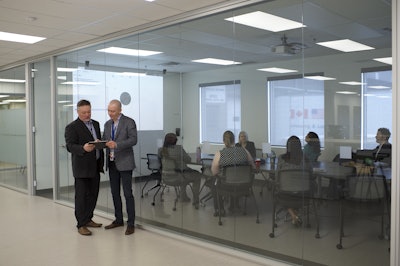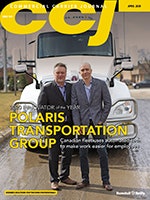 Dave Brajkovich (left) says that PTG President Dave Cox (right) is creating a culture that “allows everybody to lift to the next level. If they want to try something, we say ‘Go for it.’”
Dave Brajkovich (left) says that PTG President Dave Cox (right) is creating a culture that “allows everybody to lift to the next level. If they want to try something, we say ‘Go for it.’”Besides using technology to automate internal business systems and workflow, PTG continues to make strides to help its customers do the same by increasing connectivity options and capabilities.
PTG has built a suite of APIs that enable its business systems to connect directly with those of its customers and border agencies, Brajkovich says. Currently, the company is ahead of the market in this regard, and border-crossing agencies also are moving toward higher levels of automation.
“As they improve, we will be able to align with them,” he says. “When border agencies are ready, we will be able to send APIs throughout the process to them. Technically, we should be paper-free at some point in time.”
Currently, when drivers arrive at the border, they must have a paper copy of the load manifest. This requirement could become more flexible, Brajkovich says, and with the new technology, PTG drivers could present an electronic load manifest on their mobile device. Border agencies could scan the document to save time.
“That’s where we are going with it,” he says.
PTG also has been working with IBM to develop a blockchain platform for transportation,and Brajkovich sees this as the next wave of business-to-business connectivity. The platform uses a “distributed ledger” on a centralized hosted environment.
The platform is in the final preparatory stages of launch and is designed to ease business transactions for PTG and its customers. “We have some ideas and partners who are interested,” he says. “Once we hook them up and start going, there is no stopping us.”
With the coming blockchain developments, PTG and NorthStar have positioned themselves to provide services that go beyond RPA to integrating business models throughout the supply chain.
Besides automating business processes, the technology platforms that PTG has today are solid from a performance and security standpoint to enable the company to scale up quickly without having to invest in more IT infrastructure, Brajkovich says.
 Each night, Polaris Transportation Group dispatches 35 linehauls from Toronto into the United States. Dave Brajkovich, CTO (left) and Dave Cox have plans to make the border crossing process become paperless.
Each night, Polaris Transportation Group dispatches 35 linehauls from Toronto into the United States. Dave Brajkovich, CTO (left) and Dave Cox have plans to make the border crossing process become paperless.As PTG goes deeper into digital transformation, Cox sees opportunities to make the load-planning process for its daily line-haul schedules more fluid and dynamic. Currently, a lot of manual work is involved in setting up runs, despite having predictable departure schedules.
“We shouldn’t have to spend time setting these runs up each day,” he says. “That’s what we are going to use robotics for.”
Cox says that with the robotics, any adjustments that need to be made to plans throughout the day could be automated the moment that exceptions happen, such as a driver not making it to a pickup on time or a shipper not having freight ready.
Those uncertainties currently cause extra work when freight hits the cross-dock, but he sees more opportunities for systems to make decisions and free up human intellectual capacity to make better decisions using “cleaner” information.
Information might show a driver is two hours away from returning to the dock and will miss the cutoff time for a departure to New York City. A human could intervene and move the freight from the first line-haul departure to New York City to the third departure, Cox says.
Making these and other decisions is what humans do best, but they need the right information and to be freed from manual processes to be able to make better business decisions, he says.
With all the new technology, Cox is excited about the future, and so are PTG employees. “It makes the job fun again,” he says.
“[Dave Cox] lets us be our own entrepreneurs,” Brajkovich says. “That’s why I came here. The culture Dave is creating is really great. It allows everybody to lift to the next level. If they want to try something, we say ‘Go for it.’”
About the award
Commercial Carrier Journal’s editors recognize innovators throughout the year and select one for special recognition as the CCJ Innovator of the Year. Innovators considered for the current award were those recognized in the magazine in 2019.
Innovation in any aspect of the operation is eligible for recognition. To qualify, the carrier must operate at least 10 power units in Classes 3-8 and maintain a satisfactory safety rating, if rated. Selection of innovators for recognition is at the sole discretion of CCJ’s editorial staff.
This year’s award was announced and presented at the CCJ Innovators Summit, a networking event for current and prior-year CCJ Innovators held Feb. 5-7 in Key Largo, Fla. Representatives of the innovative trucking operations updated one another on their initiatives.
The CCJ Innovators program is sponsored by Freightliner Trucks, Omnitracs and Shell Lubricants. For more information on the program and links to previously recognized CCJ Innovators or to fill out the online nomination form, go to CCJInnovators.com, or contact Jason Cannon, CCJ editor, at 205-248-1175.















